Notes: Belfast York Road was the southern terminus of the Belfast & Ballymena Railway (B&BR) which opened on 11 April 1848. With the opening of the Londonderry & Coleraine Railway (L&CR) at the end of 1852 and the Ballymena, Ballymoney, Coleraine & Portrush Junction railway (BBC&PRR) on 4 December 1855 a through route was created between Belfast and Derry/Londonderry (although passengers had to change trains at Coleraine and cross the river there until a bridge was built linking the lines in 1859).
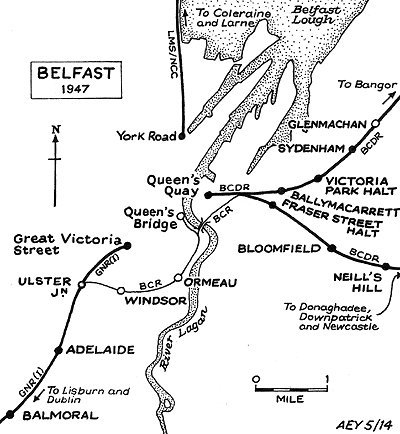 The B&BR built a large classical building with a central portico, two storeys and two pavilions. The building was designed by the architect Charles Lanyon. The station was located on the east side of York Road to the north of Whitla Street, and at the time of opening it had only one platform. The station was two miles from the centre of Belfast which had saved on the cost of constructing the railway. The B&BR built a large classical building with a central portico, two storeys and two pavilions. The building was designed by the architect Charles Lanyon. The station was located on the east side of York Road to the north of Whitla Street, and at the time of opening it had only one platform. The station was two miles from the centre of Belfast which had saved on the cost of constructing the railway.
The March 1850 timetable showed 4 arrivals and 5 departures Monday-to-Saturday. On Sundays there were 2 arrivals and 3 departures.
Following an accident at York Road a few years after opening an extra platform was added and goods facilities were moved.
In 1858 the B&BR took over the BBC&PRR and in 1860 it gained control of the L&CR and formed the Belfast & Northern Counties Railway (B&NCR). In October 1862 the B&NCR became the first company in the British Isles to carry third class passengers on all trains. This encouraged commuting into Belfast and the growth of northern suburbs which in turn brought extra traffic to the railway. In the same year the B&NCR opened a line from Carrickfergus to Larne Harbour. Larne was the closest port to the British mainland, being only 39 miles from Stranraer. A steamship service began but at first there were poor receipts and it was withdrawn only a year later. The service was reintroduced with a better ship in 1872 and became a success. Connecting services were offered from Belfast York Road to Glasgow and London.
 Between 1873 and 1875 York Road was extended. As well as the passenger facilities there was also a large goods shed to the east of the station and a locomotive depot to the north. Between 1873 and 1875 York Road was extended. As well as the passenger facilities there was also a large goods shed to the east of the station and a locomotive depot to the north.
During the 1890s York Road was extended once again. A new concourse building was provided, again in a classical style but of three storeys topped by balustrades. A clock tower was erected – a squat, rather modest affair in contrast to the buildings to which it was attached. After the 1890s rebuilding the station had six platforms.
In 1895 tram lines were laid into a purpose-built covered part of the station from York Road. They allowed trams of the Belfast Street Tramways Company (which was taken over by the City Council on 1 January 1905) to run directly into the station allowing passengers to change between trams and trains under cover. The tram facility was at the southern end of the station on Whitla Street.
By December 1895 there were 32 arrivals and 28 departures Monday-to-Saturday. On Sundays there were 9 arrivals and 8 departures. Destinations served included Ballymena, Ballyclare, Carrickfergus, Greenisland, Cookstown Junction, Larne, Larne Harbour and Derry/Londonderry.
In 1898 a hotel was built at the southern end of the station adjacent to the tram terminus. The hotel had three storeys and its main entrance was on Whitla Street.
In 1903 the B&NCR was taken over by the Midland Railway (MR) and the lines out of York Road became the Midland Railway Northern Counties Committee (MRNCC). The station hotel became the Midland Hotel.
 In 1922 the island of Ireland was partitioned into the Irish Free State (which became Eire/Ireland in 1936 and the Republic of Ireland in 1948) and Northern Ireland which remained as a constituent part of the United Kingdom. The NCC lines were almost wholly within Northern Ireland so the MRNCC did not face the difficulties experienced by some other railway companies. In 1922 the island of Ireland was partitioned into the Irish Free State (which became Eire/Ireland in 1936 and the Republic of Ireland in 1948) and Northern Ireland which remained as a constituent part of the United Kingdom. The NCC lines were almost wholly within Northern Ireland so the MRNCC did not face the difficulties experienced by some other railway companies.
In 1923 the MR was absorbed into the London Midland & Scottish Railway (LMS) who used the name LMS NCC for its Northern Ireland operations. Locomotives and rolling stock were usually branded NCC but they carried the LMS crest.
On 6 and 7 April 1941 York Road was badly damaged during a German bombing raid. The Whitla Street side of the station, including the tram terminus, and the hotel was completely destroyed. The trainshed roof was very badly damaged. The station was patched up so that trains could continue to run as the NCC lines were vital for the war effort. In 1942 the frontage was rebuilt as was the hotel, but in a much simplified form.
In 1944 complete demolition was proposed along with a re-siting of the station several blocks to the south closer to the city centre. The plan was never realised.
After the war the damaged overall roof was removed and replaced with canopies on each platform. The LMS summer timetable showed 57 departures from York Road on Monday-to-Friday. On Saturdays there were 61 departures and there was also a good service on Sundays. Services ran to destinations including Ballymena, Ballymoney, Carrickfergus, Cookstown Junction, Cullybackey, Larne, Larne Harbour, Londonderry Waterside and Whitehead.
 On 1 January 1948 the NCC lines were nationalised, becoming part of the British Transport Commission under The Railway Executive NCC. This situation did not last long and on 1 April 1949 the NCC network passed to the Ulster Transport Authority (UTA). The logo of the UTA, a circular design incorporating the Red Hand of Ulster, was installed above the station entrance on Whitla Street. On 1 January 1948 the NCC lines were nationalised, becoming part of the British Transport Commission under The Railway Executive NCC. This situation did not last long and on 1 April 1949 the NCC network passed to the Ulster Transport Authority (UTA). The logo of the UTA, a circular design incorporating the Red Hand of Ulster, was installed above the station entrance on Whitla Street.
On 21 August 1950 tram services ceased and were replaced with buses which meant that passengers could no longer change between modes under cover.
The UTA was a notoriously anti-rail organisation and from 1950 it set about closing railways all over Northern Ireland. The NCC was reduced to a quarter of the mileage that it had been and it continued to shrink over the next decade.
However, the UTA did make some investment in the railways which included the purchase of DMUs from the mid 1950s onwards. Many of the services running from York Road went over to DMU operation at this time.
The only physical connection between the former NCC lines and other railways in Belfast had been via the dock lines of the Belfast Harbour Commissioners. In 1966 this connection was lost with the closure of the Queens Bridge Subway which carried the harbour lines under the Queens Bridge on the west bank of the River Lagan.
On 5 April 1968 Northern Ireland Railways (NIR) was formed to manage all of railways in the province.
 In the late 1960s York Road station was badly damaged by an IRA bomb. NIR drew up plans for a new station at York Road that would have been similar to London Euston. As with the 1944 plans they were never realised. Instead, facing York Road, a desperately austere lump of a building was provided. Its brick-built façade was devoid of windows but had a dark, gaping entrance sheltered by a canopy with an uncomfortably deep facia bearing the name ‘York Road Railway Station’ in lettering which was fashionably off-centre. The new facilities opened in 1975. In the late 1960s York Road station was badly damaged by an IRA bomb. NIR drew up plans for a new station at York Road that would have been similar to London Euston. As with the 1944 plans they were never realised. Instead, facing York Road, a desperately austere lump of a building was provided. Its brick-built façade was devoid of windows but had a dark, gaping entrance sheltered by a canopy with an uncomfortably deep facia bearing the name ‘York Road Railway Station’ in lettering which was fashionably off-centre. The new facilities opened in 1975.
Trains to Derry/Londonderry continued to run until 1978 after which they were diverted to run to Belfast Central (opened on 12 April 1976) via the former Great Northern Railway of Ireland (GNRI) Lisburn - Antrim branch. This left York Road with only Larne line trains.
In 1980 a stopping service was introduced between York Road and Antrim but it lasted less than a year.
The NIR was a much more pro-rail organisation than the UTA had been, and it developed plans for a cross-harbour railway that would link the Larne line to Belfast Central. Work began in the 1990s and a new station called Yorkgate was opened to the east of York Road on 17 October 1992. York Road was closed and demolished, the station area becoming part of the NIR York Road depot.
Yorkgate was a terminus for two years, until 28 November 1994 when the cross-harbour line opened. Since that time Larne and Derry/Londonderry trains have run through Yorkgate station. Initially the services terminated at Belfast Central, but after the opening of a new Belfast Great Victoria Street on 30 September 1995 (the original having closed on 12 April 1976) they mostly ran to the new station that was far better located to serve the city centre than ‘Central’ station.
Tickets from Michael Stewart and route map by Alan Young
Sources:
- Bradshaws July 1922 Railway Guide, Guild Publishing
- LMS Summer Timetable 1932
- LMS Summer Timetable 1947
- One Hundred & Fifty Years of Irish Railways, Fergus Mullighan, Appletree Press 1983
- Railways in Ireland Part Two, Martain Bairstow, 2007
For more information about passenger services from
Belfast York Road click here
See Also: Yorkgate
|

york_road.jpg)
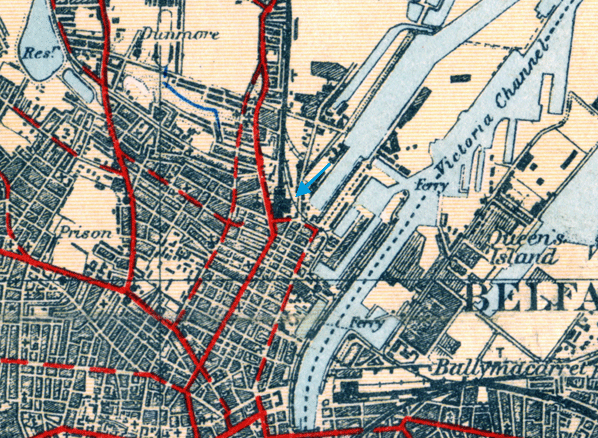
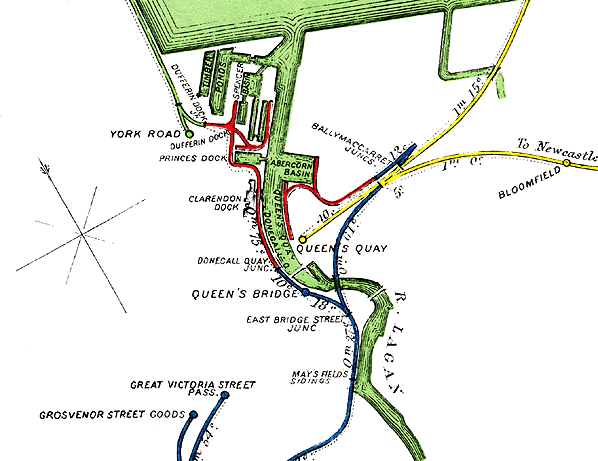
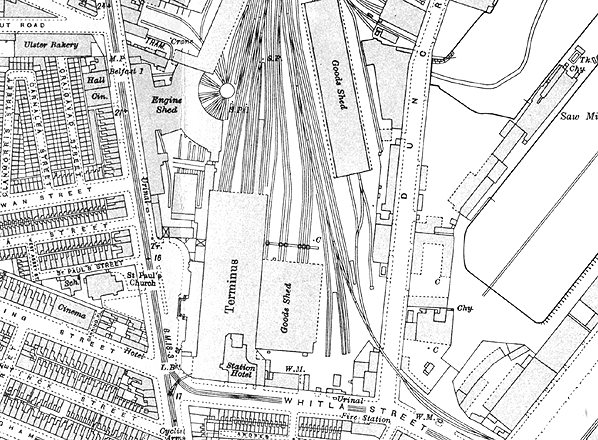 Belfast York Road shown on a 1:2500 scale map from 1920.
Belfast York Road shown on a 1:2500 scale map from 1920.york_road.jpg)
.jpg)
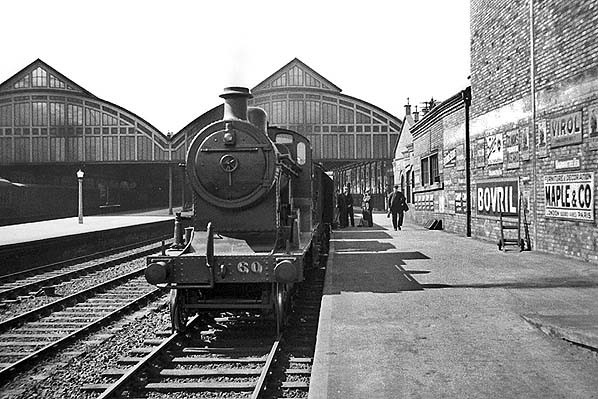
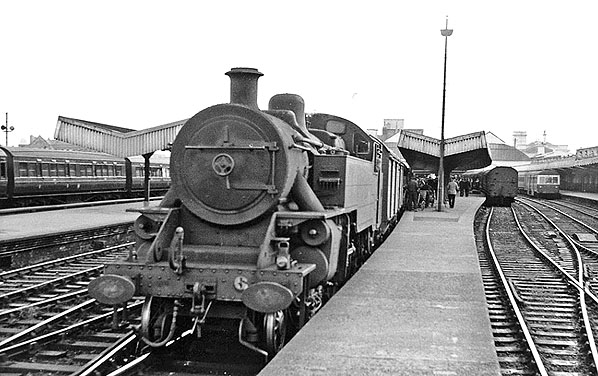
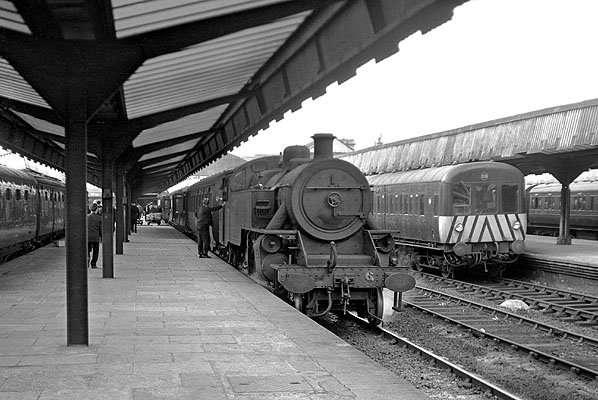
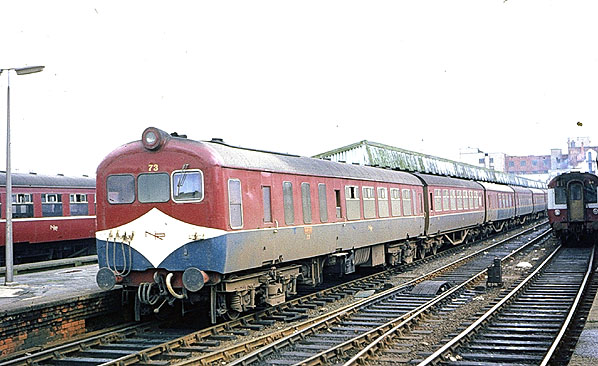
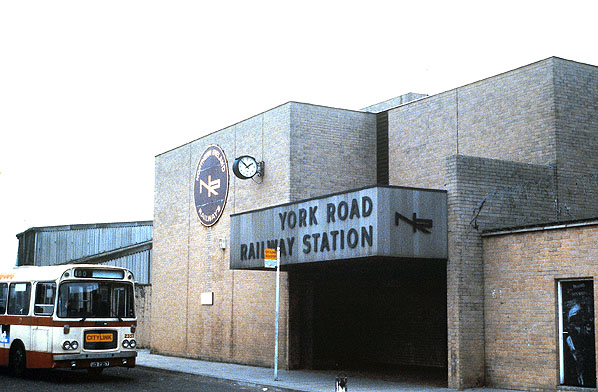
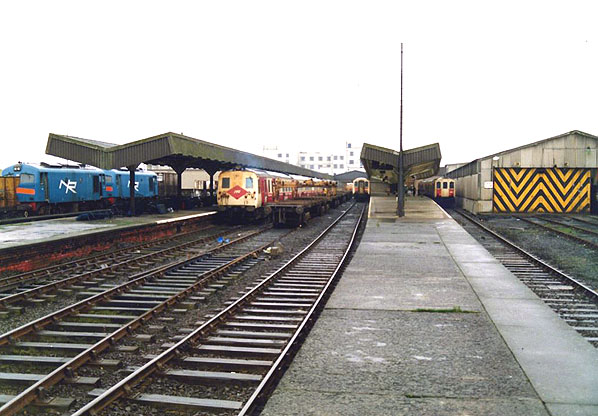
.jpg)
 The B&BR built a large classical building with a central portico, two storeys and two pavilions. The building was designed by the architect Charles Lanyon. The station was located on the east side of York Road to the north of Whitla Street, and at the time of opening it had only one platform. The station was two miles from the centre of Belfast which had saved on the cost of constructing the railway.
The B&BR built a large classical building with a central portico, two storeys and two pavilions. The building was designed by the architect Charles Lanyon. The station was located on the east side of York Road to the north of Whitla Street, and at the time of opening it had only one platform. The station was two miles from the centre of Belfast which had saved on the cost of constructing the railway.  Between 1873 and 1875 York Road was extended. As well as the passenger facilities there was also a large goods shed to the east of the station and a locomotive depot to the north.
Between 1873 and 1875 York Road was extended. As well as the passenger facilities there was also a large goods shed to the east of the station and a locomotive depot to the north.  In 1922 the island of Ireland was partitioned into the Irish Free State (which became Eire/Ireland in 1936 and the Republic of Ireland in 1948) and Northern Ireland which remained as a constituent part of the United Kingdom. The NCC lines were almost wholly within Northern Ireland so the MRNCC did not face the difficulties experienced by some other railway companies.
In 1922 the island of Ireland was partitioned into the Irish Free State (which became Eire/Ireland in 1936 and the Republic of Ireland in 1948) and Northern Ireland which remained as a constituent part of the United Kingdom. The NCC lines were almost wholly within Northern Ireland so the MRNCC did not face the difficulties experienced by some other railway companies.  On 1 January 1948 the NCC lines were nationalised, becoming part of the British Transport Commission under The Railway Executive NCC. This situation did not last long and on 1 April 1949 the NCC network passed to the Ulster Transport Authority (UTA). The logo of the UTA, a circular design incorporating the Red Hand of Ulster, was installed above the station entrance on Whitla Street.
On 1 January 1948 the NCC lines were nationalised, becoming part of the British Transport Commission under The Railway Executive NCC. This situation did not last long and on 1 April 1949 the NCC network passed to the Ulster Transport Authority (UTA). The logo of the UTA, a circular design incorporating the Red Hand of Ulster, was installed above the station entrance on Whitla Street.  In the late 1960s York Road station was badly damaged by an IRA bomb. NIR drew up plans for a new station at York Road that would have been similar to London Euston. As with the 1944 plans they were never realised. Instead, facing York Road, a desperately austere lump of a building was provided. Its brick-built façade was devoid of windows but had a dark, gaping entrance sheltered by a canopy with an uncomfortably deep facia bearing the name ‘York Road Railway Station’ in lettering which was fashionably off-centre. The new facilities opened in 1975.
In the late 1960s York Road station was badly damaged by an IRA bomb. NIR drew up plans for a new station at York Road that would have been similar to London Euston. As with the 1944 plans they were never realised. Instead, facing York Road, a desperately austere lump of a building was provided. Its brick-built façade was devoid of windows but had a dark, gaping entrance sheltered by a canopy with an uncomfortably deep facia bearing the name ‘York Road Railway Station’ in lettering which was fashionably off-centre. The new facilities opened in 1975. 
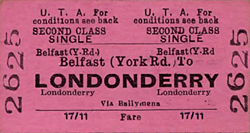

 Home Page
Home Page